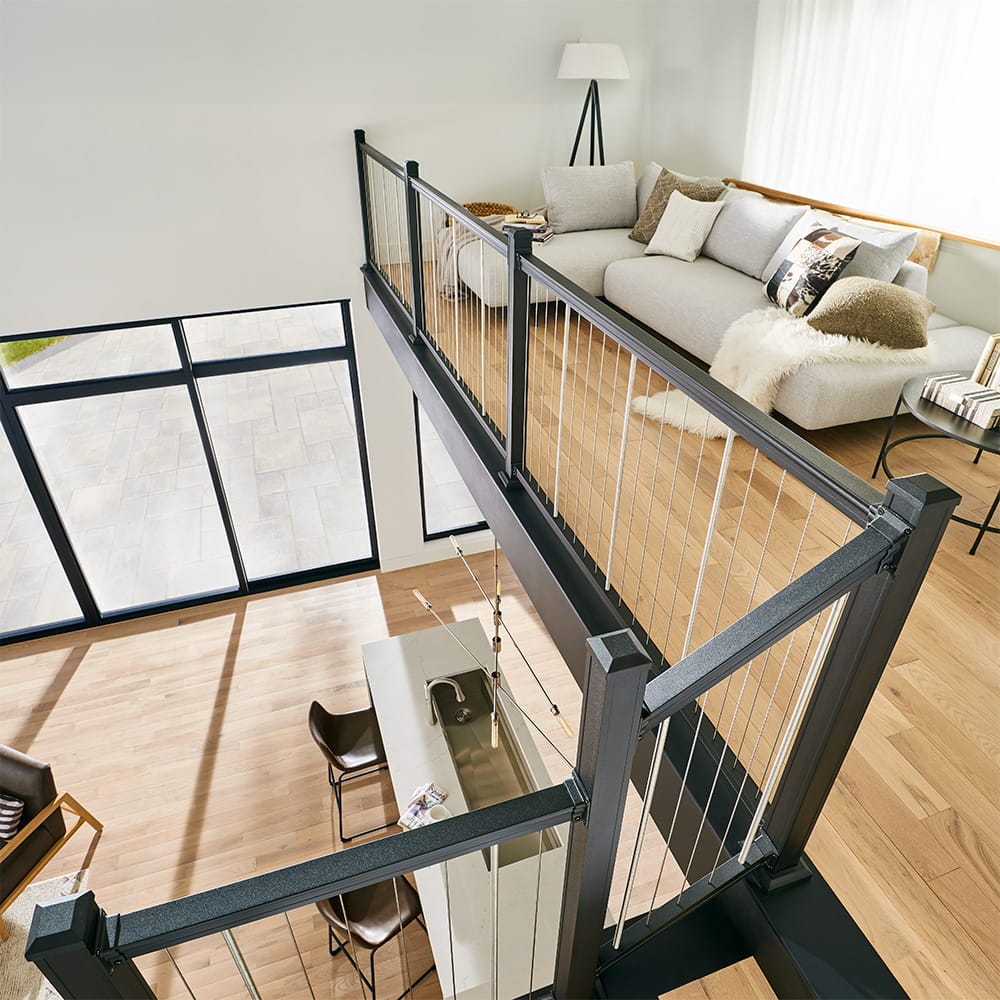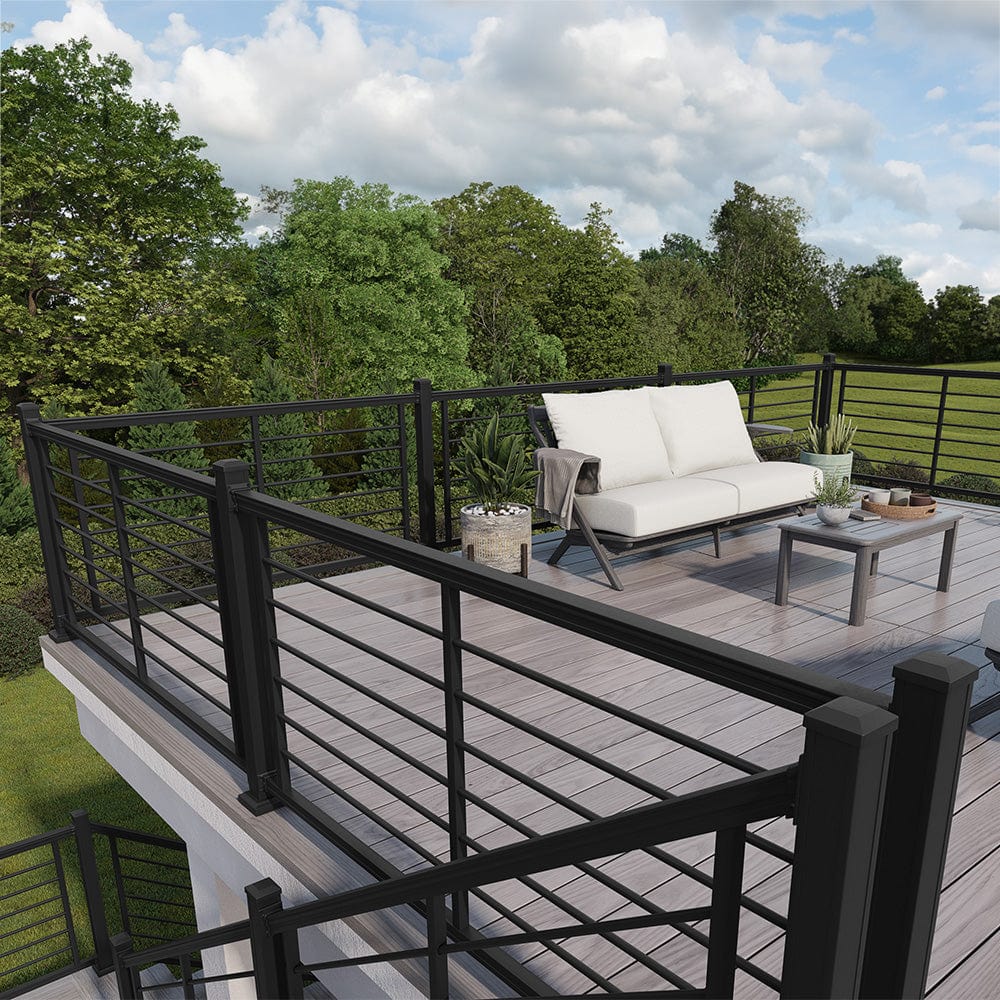Popular categories
Deck Railing: Aluminum, Cable & Glass Systems
The right deck and porch railing makes your space feel safe and look put together. Use this guide to quickly choose between aluminum, cable, and glass railing, then compare leading options from Keylink, Deckorators, IG Railing, and RailFX. Every system here is engineered for everyday use, harsh weather, and clean design.
How to choose in 60 seconds
Pick the path that fits your project, then scan the comparison table.
- Family first: Vertical cable or aluminum balusters limit footholds on stairs and landings.
- View forward: Cable or glass keeps sightlines clear with slim profiles and minimal visual weight.
- Low maintenance: Powder-coated aluminum resists corrosion and avoids sanding or painting.
- Budget aware: Aluminum baluster kits deliver a polished look at a friendly price.
| Material | Best for | Maintenance | Cost | Notes |
|---|---|---|---|---|
| Aluminum | Everyday use, Coastal | Wash with soap and water; powder coating protects finish | $$ | Strong posts, clean top rail, ADA handrail add-ons, no welding required |
| Cable (horizontal or vertical) | Modern look Open feel | Check tension yearly; stainless steel resists rust with care | $$$ | 316 stainless cable, slim brackets, smooth graspable handrail options |
| Glass (frameless or post-to-post) | Wind shelter Waterfront | Routine glass cleaning | $$$$ | Tempered panels, optional top rail, sleek spigots, great for patios and balconies |
Aluminum deck railing
Durable, light, and low maintenance with classic to modern profiles.
Aluminum rail systems use powder coated posts, top rails, and brackets for long service life. They resist corrosion in rain, snow, and sun. Choose square balusters for a traditional look or slim profiles for a modern feel. Finishes include textured black, textured bronze, matte white, and more to match your deck boards and trim.
- Finish quality: In house powder coating helps the color stay consistent across posts, rails, and brackets.
- Heights: Most systems offer 36" and 42" options for decks, porches, and balconies.
- Upgrades: Drink rail caps, post cap lighting, accent lighting, and ADA compliant secondary handrails for stairs.
- Mounting: Surface mount and fascia mount post solutions free up floor space at the edge.
Cable deck railing
Slim stainless cables with aluminum posts create a clean, modern line.
Horizontal cable suits contemporary decks and long runs. Vertical cable is popular for families who want less climbability on stairs and landings. Posts and intermediate balusters come pre-drilled. Fittings and through-sleeves support smooth runs around corners and on stairs.
- Materials: Marine grade 316 stainless steel cable with aluminum posts and stainless fasteners.
- Spacing: Typical 3 in cable centers with intermediate support to maintain tension.
- Care: Wipe down, check tension on schedule, and avoid harsh cleaners.
- Looks: Matches black, bronze, white, or mixed metal designs.
Glass deck railing
Minimal hardware and tempered panels for a refined, high-end finish.
Frameless glass uses low-profile spigots or clamps to secure tempered panels. It reduces wind on exposed decks and keeps views feeling wide. Choose clear for maximum brightness or frosted for privacy. A low-profile top rail is optional if you prefer a continuous handhold.
- Hardware: Stainless spigots and connectors in matte black or polished finishes.
- Glass: Tempered panels sized for 36 in or 42 in rail heights; low-iron options increase clarity.
- Lighting: Some spigot systems accept plug-and-play LED lighting for night appeal.
Mounting, stairs & porches
Plan posts, brackets, and handrails early for a smooth install.
Mounting types
- Surface mount posts: Attach to framing with structural anchors on wood or concrete.
- Fascia mount posts: Bolt to the rim joist to save deck surface space. Use system-specific brackets and wedges.
Stairs
Most kits cover common stair angles. Use the system’s stair brackets and wedges for clean alignment. Add a graspable secondary handrail on stairs when required.
Porches & balconies
All three types work on porches and balconies. Verify height and baluster spacing for your use, especially with sleeping rooms and multi-family spaces.
For detailed code guidance, consult your local authority or the International Code Council resources here. Learn more about powder coating standards at the Powder Coating Institute here.
Featured brands
Pro-grade systems with fast installs and proven finishes.
Keylink
American made aluminum with refined profiles and accessories. Cable options include horizontal and vertical layouts. Color families include textured black, textured bronze, and matte white, with coastal upgrades available.
Deckorators
Matched looks with Deckorators decking. Aluminum balusters, cable infill, and composite rail kits with lighting and drink rail options.
IG Railing
Frameless glass with sturdy spigots and optional LED lighting for a clean, contemporary edge. Clear and low-iron glass options deliver bright results.
RailFX
Clean, modern cable kits with engineered posts and fittings for straight runs and stairs. A solid pick for wood and composite decks.
Plan your deck railing
Tell us about your layout, height, and finish preferences. We’ll build a parts list and price.
Get a Free QuoteFrequently asked questions
What height should deck railing be?
Many residential decks use 36 in rail height. Some spaces and multi-family projects use 42 in. Confirm locally before you buy.
Can I mount posts to concrete or fascia?
Yes. Use the manufacturer’s surface-mount base for concrete, or the fascia-mount brackets and wedges designed for your system.
How do I install railing posts?
Lay out post locations, fasten bases with structural anchors, plumb and tighten, then add top rail, infill, and handrail. Follow the kit guide for bracket and fastener placement.
Which material is easiest to maintain?
Aluminum. Rinse with water and mild soap. Cable needs periodic tension checks. Glass needs routine cleaning.
Do I need a separate handrail on stairs?
Often yes. Many areas require a graspable handrail on at least one side of stairs. Add an ADA-compliant secondary handrail to meet this need.
About the Author: Jonathon Sims has guided homeowners and contractors to the right railing systems for over 13 years, from quick weekend projects to complex multi level decks.






